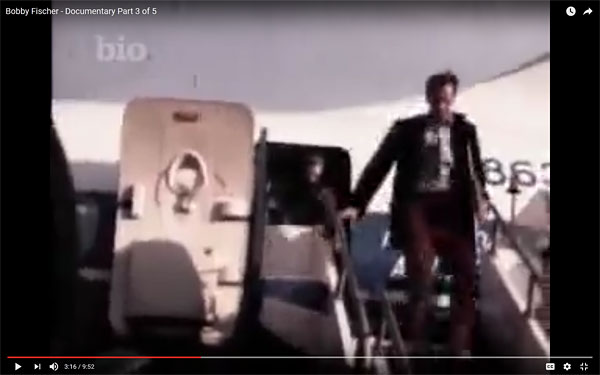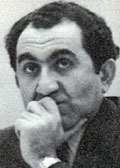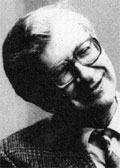Bobby Fischer arrives in Iceland
Forty-five years to the day after the start of the premier Cold War sporting event, I would like to describe the occurrences that at the time electrified the chess world and the international media. They may be well known to many of you, but I recently spoke to a young grandmaster who had only a vague idea of what took place in Reykjavik. He apologised for this, but I told him it was understandable – it happened before his parents were born! For him and other young players we re-enact the drama.
The “Match of the Century” between World Champion Boris Spassky, USSR, and his challenger Bobby Fischer, USA, was due to start, in the first days of July 1972 in Reykjavik, Iceland. Spassky, who had the backing of the mighty Soviet chess machine behind him (the title of World Chess Champion had been held by USSR citizens for twenty-four years), had arrived in the Icelandic capital well on time. But his opponent, the maverick US grandmaster Fischer, who was working essentially all on his own, sat in New York, unsatisfied with the conditions.
The Championship was to be a 24-game match in which the reigning champion had draw odds: if the match ended in a 12:12 tie, the title would remain with Spassky. Fischer's Elo rating was 2785, 125 points higher than Spassky's (2660). The prize fund was $125,000 – 5/8ths to the winner, 3/8ths to the loser. But in addition Fischer was demanding 30% of the proceeds from television and film rights plus 30% of the box-office receipts – to be split between him and Spassky. When these demands were not met Fischer, who was booked to travel to Iceland on June 25, 1972, cancelled his flight.

During the first days of July 1972 Fischer was in Douglaston, New York, staying in the house of his long-time friend IM Anthony Saidy. In this 1½-hour documentary, starting at 22 minutes, Saidy describes his attempts to get Bobby to Iceland.
Since Fischer had not arrived on July 1st the lavish opening ceremony in Reykjavik’s National Theater took place without him. The first game was scheduled for July 2nd, but Fischer was still not there. The Russians demanded a forfeit for the game, while FIDE President (and former World Champion) Max Euwe, contrary to regulations, postponed the start by two days. He set Fischer a firm deadline: July 4th, noon, Reykjavik time.

On July 3rd things looked bad. Fischer was still in Anthony Saidy's house, sulking. Then British financier James Slater (above) publicly offered to add $125,000 to the prize fund, doubling it. On the same day US Secretary of State Henry Kissinger phoned Fischer from Washington: “This is the world’s worst chess player calling the world’s best chess player,” he is famously reported to have said; and: “America wants you to go over there and beat the Russians. Get your butt over to Iceland.”
That evening Fischer was driven to John F. Kennedy airport and smuggled on board Loftleiðir (Icelandic Airlines) flight 202A to Reykjavik. The plane took off at 10.04 p.m., some three hours later than scheduled – Fischer had kept the flight waiting, and some passengers were even taken off the plane at the last moment to make room for Fischer’s entourage.

In the early hours of July 4th, 1972, some five hours before the expiration of Euwe's deadline, Fischer arrived at Iceland’s Keflavik airport. The previous two screen grabs are from this five-part Bobby Fischer documentary (specifically part three, starting at 2:30 min). He was greeted by a large group of press reporters and Icelandic dignitaries, whom he ignored, jumping into a waiting car that drove him to Reykjavik, an hour away from the airport. He took residence in a three-room suite at the Hotel Loftleidir.
For a detailed description of the prelude to the Match of the Century we turn to Prof. Christian Hesse's article A great moment in chess Part 1. Hesse writes:
Now that Fischer was on the island, not all problems had disappeared. As Gudmundur Thorarinsson, President of the Icelandic Chess Federation, indicated: “You Americans think the only problem is to get Bobby here. You don't understand it is just as important – and maybe more difficult – to keep the Russians here.”
Indeed, the Russians were infuriated by the two-day postponement that Euwe had granted to Fischer. And there were discussions on their side to call off the match. Several meetings took place in Reykjavik behind the scenes, at all hours of the day and night. At the highest level, the level of the Central Committee of the Communist Party of the Soviet Union, the view was held that Fischer's conduct constituted a humiliation of the World Champion. And there are indications that, at least for a while, efforts were under way to summon Spassky home. A strongly worded telegram was sent to grandmaster Lothar Schmid, the German referee of the match, by the Soviet Chess Federation, complaining about Fischer's conduct and Euwe's reaction to it.
The expectations before the start of the match, which (spoiler alert!) actually took place, are described by Prof. Christian Hesse in A great moment in chess Part 2:
Prior to their Reykjavik encounter, the two protagonists had contested five games, resulting in three wins for Spassky and two draws. On every occasion he had played the white pieces against Fischer, Spassky had opened with the Queen's Pawn, while in his world title match with Petrosian, which won him the crown, Spassky had built his repertoire around 1.e4.
After almost a year of extensive and systematic preparation, what will he now play against Fischer? Did his team's microscopic study of Fischer's games unearth subtle weaknesses in his opponents' handling of closed systems or will it have convinced Spassky to openly strike at Fischer with 1.e4 – the most daring move against Fischer's repertoire, inviting Poison Pawn variations of the Sicilian complex, hence demonstrating a willingness to enter the most dangerous lines which Fischer has analysed for years?
One should not forget that virtually all of the top Russian chess players were involved in assisting Spassky during his preparation: Karpov played secret training matches with Spassky, Tal as well as Petrosian, Keres, Smyslov wrote detailed confidential memos about Fischer's strengths and weaknesses. Some of these have only recently surfaced from Russian archives. Here are quotes from a selection of these memos.
 Mikhail Tal: ”In the Sicilian Defence Fischer, as a rule, sticks to well-tried systems when playing white. These are the Sozin Variation (2…Sc6 and 5…d6), the Rauzer Attack, and the Dragon Variation – systems with g3 (I think that 5.Nb5 can be dismissed) against the Paulsen Variation. The only variation in which Fischer does not always stick to the same moves is his favourite 2…d6 and 5…a6. Also 6.Bc4, 6.h3, and 6.Bg5. Perhaps, the American should be »sounded out« – 24 games provide enough time for that.
Mikhail Tal: ”In the Sicilian Defence Fischer, as a rule, sticks to well-tried systems when playing white. These are the Sozin Variation (2…Sc6 and 5…d6), the Rauzer Attack, and the Dragon Variation – systems with g3 (I think that 5.Nb5 can be dismissed) against the Paulsen Variation. The only variation in which Fischer does not always stick to the same moves is his favourite 2…d6 and 5…a6. Also 6.Bc4, 6.h3, and 6.Bg5. Perhaps, the American should be »sounded out« – 24 games provide enough time for that.
Fischer's reaction to 1…c6 appears to be not too impressive. In any case, the system he used against Petrosian, ought not to be too dangerous. Also, in my view, his reaction to 3…Nf6 in the Ruy Lopez (he used 6.Bg5 at a tournament in the USA) can hardly be a potent argument against this system. If it were possible to divert Fischer from his favourite system in the Sicilian Defence, Spassky's task would be greatly facilitated. I am sure that you are exploring ways to do so (for instance, 6.Bg5 and 6.Be2 – Geller).
I would like to draw your attention to the sequence of moves 1.e4 c5 2.Nf3 d6 3.Nc3. In the two games known to me Fischer did not play 3…Nf6. Against Kurajica (Zagreb 1970) he continued 3…Na6, and in a lightning chess tournament against me he played 3…e5. In both games Fischer's opening position was dubious. Perhaps he doesn’t like 4.e5?”
 Tigran Petrosian:
Tigran Petrosian:
(a) The Sicilian Defence with 2…d6 and 5…a6 is currently going through a serious crisis in the case of both 6.Be2 and 6.Bg5. It is a matter of taste which plan is to be preferred and perfected.
(b) Against the King's Indian Defence and the Grunfeld Defence, systems must be chosen that give White a pawn preponderance in the center.
(c) In reply to 1.e4 practically any opening can be used against Fischer with the exception of 1…e5 (the Ruy Lopez).
(d) Fischer has to be »raced« through many openings playing both white and black.
 Keres: ”Because Fischer hardly ever plays anything but 1.e4 when white, preparation is fairly circumscribe. Fischer's range when playing black is also fairly narrow: in response to 1.e4 he chooses the Sicilian Defence and in response to 1.d4 he prefers the King's Indian Defence, the Grunfeld Defence, or the Queen's Gambit. He tries to steer the game towards these systems after 1.Nf3, too, and often responds with 1…c5 to 1.c4. Perhaps, then he can be caught out with the Tarrasch Defence, colours reversed? Fischer has hardly ever played this opening, while Spassky likes it and plays it superbly. In general, such a strategic opening with some exciting tactical possibilities seems to be a suitable weapon, especially because White has made an extra move.
Keres: ”Because Fischer hardly ever plays anything but 1.e4 when white, preparation is fairly circumscribe. Fischer's range when playing black is also fairly narrow: in response to 1.e4 he chooses the Sicilian Defence and in response to 1.d4 he prefers the King's Indian Defence, the Grunfeld Defence, or the Queen's Gambit. He tries to steer the game towards these systems after 1.Nf3, too, and often responds with 1…c5 to 1.c4. Perhaps, then he can be caught out with the Tarrasch Defence, colours reversed? Fischer has hardly ever played this opening, while Spassky likes it and plays it superbly. In general, such a strategic opening with some exciting tactical possibilities seems to be a suitable weapon, especially because White has made an extra move.
White in response to Sicilian Defence 2…d6 and 5…a6: it is a very complicated system which, after 6.Bg5, calls for a lot of preparation. Because Fischer has worked a lot on this and knows the position well I would not recommend 6.Bg5, unless the situation is desperate. I believe that 6.Be2 would be more practicable, especially because Geller is a great connoisseur of that system. Consideration can also be given to 6.f4 which often gives White a chance to attack the king. The move 6.Be3 has not been sufficiently explored for any judgments to be passed on it.”
 Smyslov: ”The repertoire of openings must be diversified and tailored to Fischer's specific variations.
Smyslov: ”The repertoire of openings must be diversified and tailored to Fischer's specific variations.
a) For instance, one may consider 6.Be2 in the Sicilian Defence with the knight moving from f3 to b3. Any scheme must be carefully thought out and hold the promise of parity if an advantage is not gained. In other words, a large safety margin must be created.
b) In reply to the King's Indian Defence the Samisch System can be used, and also a calm development, for example, 1.d4 Nf6 2.c4 g6 3.Nc3 Bg7 4.Nf3 d6 5.Bg5, etc. In the Grunfeld Defence it would be interesting to explore the system with 4.Qb3 and 4.Bf4.
c) In reply to 1.e4, classical systems with 1…e5 must be prepared. I can recommend the Petroff Defence as well as the Ruy Lopez in its classical shape with Nc6-a5 and c7-c5 modelled on Fischer's games with Kholmov (Havana 1965) and O'Kelly (Buenos Aires 1970) updated in line with modern theory.
d) I do not believe in the strength of Black's defence in the variation much favoured by Fischer: 1. c4 c5 2. Nf3 g6 3. d4 cd4 4. Nd4. The Maroczy formation with pawns at c4 and e4 promises a solid initiative to White.”
In early June this year I visited Iceland, on my first real holiday in sixteen years (some readers noticed that I did not post a single report during the time). In Reykjavik I met up with an old and dear friend, Gardar Sverrisson. We drove around the city and he showed me all the places he had frequented with Bobby. In particular we visited the original venue of the match. This is the subject of my next report.
You might be interested to know that there is a five-hour Master Class DVD on the American Chess genius in the ChessBase Shop
 Master Class Vol. 1: Bobby Fischer Master Class Vol. 1: Bobby Fischer
By Dorian Rogozenco, Dr. Karsten Müller, Mihail Marin, Oliver Reeh
Languages: English, German
ISBN: 978-3-86681-371-7
Delivery: Download, Post
Level: Any
€29.90 or €25.13 without VAT (for Customers outside the EU); $28.39 (without VAT)
No other World Champion was more infamous both inside and outside the chess world than Robert James Fischer. But what were the secrets to his sensational ability, and what enabled him to take on the Soviet school of chess alone – and win? On this DVD, a team of experts presents you every facet of the chess legend, and shows you the winning techniques and strategies employed by the 11th World Champion. Grandmaster Dorian Rogozenco delves into Fischer’s openings, and retraces the development of his repertoire. What variations did Fischer play, and what sources did he use to arm himself against the best Soviet players? Mihail Marin explains Fischer’s particular style and his special strategic talent in annotated games against Spassky, Taimanov and other greats. Karsten Müller is not just a leading international endgame expert, but also a true Fischer connoisseur. His congenial video analysis of Fischer’s legendary endgames can only be found on this DVD! To top it off - you too can unleash tactical combinations like Fischer! German Bundesliga player Oliver Reeh has compiled the World Champion’s best combinations – and now it’s your move. You too can try to find Fischer’s stunning brilliancies by entering your solution on the board and receive video feedback in the new ChessBase media format!
• Video running time: approx 5 hours (English)
• Interactive training including video feedback
• Collection of every Fischer game, tables, backround knowledge, short biography
• “Fischer powerbook”– the World Champion’s repertoire as an opening tree
• Tactic training: 100 Fischer games with training questions.
Order Master Class on Bobby Fischer in the ChessBase Shop |





















 Mikhail Tal: ”In the Sicilian Defence Fischer, as a rule, sticks to well-tried systems when playing white. These are the Sozin Variation (2…Sc6 and 5…d6), the Rauzer Attack, and the Dragon Variation – systems with g3 (I think that 5.Nb5 can be dismissed) against the Paulsen Variation. The only variation in which Fischer does not always stick to the same moves is his favourite 2…d6 and 5…a6. Also 6.Bc4, 6.h3, and 6.Bg5. Perhaps, the American should be »sounded out« – 24 games provide enough time for that.
Mikhail Tal: ”In the Sicilian Defence Fischer, as a rule, sticks to well-tried systems when playing white. These are the Sozin Variation (2…Sc6 and 5…d6), the Rauzer Attack, and the Dragon Variation – systems with g3 (I think that 5.Nb5 can be dismissed) against the Paulsen Variation. The only variation in which Fischer does not always stick to the same moves is his favourite 2…d6 and 5…a6. Also 6.Bc4, 6.h3, and 6.Bg5. Perhaps, the American should be »sounded out« – 24 games provide enough time for that. Tigran Petrosian:
Tigran Petrosian: Keres: ”Because Fischer hardly ever plays anything but 1.e4 when white, preparation is fairly circumscribe. Fischer's range when playing black is also fairly narrow: in response to 1.e4 he chooses the Sicilian Defence and in response to 1.d4 he prefers the King's Indian Defence, the Grunfeld Defence, or the Queen's Gambit. He tries to steer the game towards these systems after 1.Nf3, too, and often responds with 1…c5 to 1.c4. Perhaps, then he can be caught out with the Tarrasch Defence, colours reversed? Fischer has hardly ever played this opening, while Spassky likes it and plays it superbly. In general, such a strategic opening with some exciting tactical possibilities seems to be a suitable weapon, especially because White has made an extra move.
Keres: ”Because Fischer hardly ever plays anything but 1.e4 when white, preparation is fairly circumscribe. Fischer's range when playing black is also fairly narrow: in response to 1.e4 he chooses the Sicilian Defence and in response to 1.d4 he prefers the King's Indian Defence, the Grunfeld Defence, or the Queen's Gambit. He tries to steer the game towards these systems after 1.Nf3, too, and often responds with 1…c5 to 1.c4. Perhaps, then he can be caught out with the Tarrasch Defence, colours reversed? Fischer has hardly ever played this opening, while Spassky likes it and plays it superbly. In general, such a strategic opening with some exciting tactical possibilities seems to be a suitable weapon, especially because White has made an extra move. Smyslov: ”The repertoire of openings must be diversified and tailored to Fischer's specific variations.
Smyslov: ”The repertoire of openings must be diversified and tailored to Fischer's specific variations. Master Class Vol. 1: Bobby Fischer
Master Class Vol. 1: Bobby Fischer




